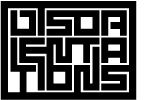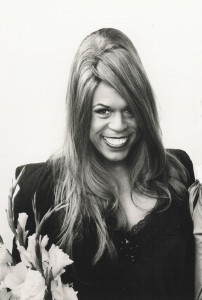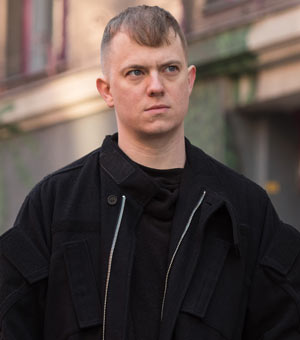Jacqueline Brown @ STYX Project Space, Berlin
by Travis Jeppesen on May 25, 2009
In her first solo exhibition, Jacqueline Brown uses drawings, photography, sound, and video to compose a sort of exercise in landscape autobiography. Mining the flora and fauna of the English countryside around Devon, where the young artist spent her childhood, Brown puts her training as a sculptor to spectacular effect in Pine Family I-III, three large pencil drawings depicting wild foliage cut into expressive shapes across blank white paper. On the opposite wall, tiny scattered portraits of coniferous branches go even further towards isolating Brown’s motif; they actually portray expired Christmas trees laying in the streets of Berlin after the last holiday, awaiting their deportation to the garbage dump.
A similar collage technique is tried out in A Long Narrow Territory, only using digital photography rather than pencil. From a distance, we seem to be looking at a long horizontal stain; up close, we are able to make out the details of a green autumnal landscape dotted with farms, hilly expanses, and leafless trees.
Brown’s lyrical prowess moves beyond static imagery in the second part of the exhibition, which focuses on a pack of hunting hounds. A four-minute video, 38 ½ Couple, shows the secret life of these noble beasts as they are held in captivity, anxiously awaiting the next hunt, while an accompanying inkjet print posted on the wall contains the names of each and every one of the dogs structured into seemingly random alphabetized groups, eliciting a peculiar poetry of the proper name.
Refuting both science and polemic, Brown’s new naturalism steers clear of romantic cliché, instead giving us a raw inference of the universe’s elasticity across time, as well as the occasionally bizarre methods that culture has of interfering with its wildness.
The exhibition runs until May 29th. That night, there will be a finissage at the gallery with the artist present.
Vaginal Davis Wins 2009 Ethyl Eichelberger Award
by Travis Jeppesen on May 2, 2009
Congratulations to Vaginal Davis, Berlin-based genius performance artist, for winning this year’s Ethyl Eichelberger Award. Ms. Davis continues to push buttons and boundaries with her work, scattered across countless disciplines and media. She is one of the most extraordinary living, breathing, walking works of art we’ve had the pleasure to encounter, and I’m honored that she’ll be starring in my upcoming play, Daddy, at the HAU Theater in Berlin in June.
This Ethyl Eichelberger Award is given “to an artist who exemplifies Ethyl’s larger-than-life style and generosity of spirit; who embodies Ethyl’s multi-talented artistic virtuosity, bridging worlds and inspiring those around them.” Davis will receive a show in the spring 2010 season at Performance Space 122 as well as a stipend for its creation.
Cy Twombly in London
by Travis Jeppesen on May 1, 2009
Over at WhiteHot Magazine of Contemporary Art, you’ll find my review of Cy Twombly’s current exhibition at Gagosian Gallery.
Queer Art in Central Europe: Travis Jeppesen on Mark Ther
by Travis Jeppesen on April 30, 2009
This is a transcription of my recent lecture on Mark Ther at the Sixth Culture for Tolerance Festival in Krakow, Poland. The lecture was adapted from my essay on Mark Ther in Disorientations: Art on the Margins of the “Contemporary” (Social Disease, 2008). Unfortunately, most of the videos I showed are not currently available online.
I lived in the Czech Republic for five years, during which time I never noticed any such phenomenon as “queer art,” even though I was making a living primarily as an art critic. I don’t even know if there was much awareness in the gay scene at that time of the concept “queer.” If there was, there wasn’t much talk about it. Oddly enough, the entire time I lived there – between the years of 2001 and 2006 – there was virtually no overlap between the artists I hung out with and my gay friends. The artists weren’t gay – or at least, those who were didn’t want to talk much about it – and the gays weren’t artists and didn’t know much about art. The only person who seemed to live in both of these worlds as comfortably as I did was Mark Ther, whom I didn’t meet until 2005. Ther was in his final years of art school at that time, but he had already produced an impressive body of videos and short films, both by himself and in collaboration with others. I don’t remember what came first – my meeting him in person or my awareness of his work. I believe it was Ond?ej Brody, an artist with whom Ther was frequently collaborating at the time, who invited me for a dual studio visit. There, I was shown videos that Brody and Ther had created collaboratively, as well as their individual work. This piece, Ther, is from 2003, and was a collaborative work. [Show Ther*]
At this time, both Brody and Ther were involved with EgoArt, a sort of fake art movement started by the young Slovak artist Viktor Frešo based on an absurd philosophy of self-promotion and self-glorification. (It can be read as a satirical response to the hyper-capitalistic impulses that motivate the global art market.) Frešo and his peers went so far as to establish an EgoArt prize – I believe the Azorro Group from Poland won it in 2004 – the only rule of which appears to be that you have to nominate yourself. Ther and Brody started titling their collaborative works with variations of their names Ther, Brody, and in the case of AndyTher & MarkBrody, scrambling their names together – effectively embracing the EgoArt concept while simultaneously dispelling any efforts at creating a brand name identity. If there is now such a thing as a “queer aesthetic” in Czech art, these early collaborations between the two artists are probably where it begins. Brody may identify as heterosexual, but of course the concept “queer” eludes such normative sexual assignations, just as Brody and Ther were playfully refuting the sort of name-branding that EgoArt playfully promotes – a parody of a parody.
In 2004, Mark Ther went off to New York to study at the Cooper Union for the Advancement of Science and Art. Brody remained in Prague, where his practice became more performance-oriented. [Show Artstar episode*]
Ther used his time in New York to make videos exploring his love of dancing, ‘80s cheeseball music, and retro American cars. In Chevrolet Caprice Classic (2004), an attractive young man wearing black tights and a neon pink and green windbreaker vogues gaily in the middle of the ghetto. But what is that he has his eye fixed on in the distance? Perhaps another good-looking boy? No. It’s a white Chevrolet Caprice Classic parked on the edge of an abandoned lot. A boogie-woogie Motown anthem plays. The camera, at this point, becomes more interested in the car than the boy. It moves up and down the car’s trashy exterior as the music jolts and jives onwards, then loses interest and begins to slowly survey the garbage-strewn yard next to the vehicle, when its lazy wandering path is interrupted by a boot that the boy has apparently tossed in our way. The screen goes black, the credits roll, and the music plays onwards.
Another video produced during his stay in New York was Burger and Ther. [Show Burger and Ther]
Is this “queer art”? For me, such questions always have to do with language – that is, they exist only within language, language as an externalized system of categories for understanding the world. If we start here, we might be able to come up with a definition of “queer” through Mark Ther’s work.
When I first saw these early works, I was at a precocious time in my development as a poet. In my work I was attempting to use language as a plasticized material, detached from meaning, in order to focus more on the intricacies of sound, and through playful and often violent juxtapositions, forging new meanings – so I was using language more as a sculptural material or as a composer would use different instruments – both at once, really – than I was as a writer in the traditional sense of the term. As such, my consideration of language had evolved from treating it merely as a spoken and written phenomenon – which, I believe, is how most people tend to view language – to something with much broader applicability, something that could include the visual and musical realms. (Remember, this was also the time I was making my first forays into art criticism.) In Burger and Ther, I was interested in how Mark Ther got around language, in the traditional sense, through evolving a visual language that was nevertheless highly sophisticated. It was a language loaded with easily recognizable symbols, yet one that didn’t bother with meaning. I guess this is what mattered to me the most – a rejection of what an academic might call the “sovereignty of narrative,” or, what I’ve always thought of as the artist’s right, if not duty, to not make sense, at least not in those places where there is a common consensus. In the world of normal language, the world that I’m speaking in right now, that is. In the world presented in Burger and Ther, of course, the sounds and images manage to function as autonomous parts in the formation of a worthy whole – but the message can’t be translated, just like emotions so often seem to escape behind the letters of the names we give them.
This was one of Ther’s first films in which he deploys a proper narrative – in this respect, it’s a very experimental film for him!
[Show: Der Kleine Blonde und sein roter Koffer]It is a simple story, actually taken from a German language textbook, but it’s a deceptive simplicity because it deals with emotions so complex that they often elude our understanding. For it is often the most meaningless occurrences that lodge themselves deepest in our memory, things that we turn back to again and again when we’re feeling nostalgic for a past that we may not have even been a part of. It’s the sadness that comes with that longing that somehow preserves us in the integrity of the present; without looking back, we have little impetus to move forward; yet becoming too caught up in the past can also impede our movements. What, after all, is more tempting and yet more untouchable than the very fabric of our lives?
This double-edged sword, where the unknowable meets the unmanageable, is again raised in I Will Get You Out and Chop You Up in Midair, a short film from 2007, in which an unseen male voice addresses a dead man worm-crawling across a grassy backyard garden (in French):
It’s pathetic that you believe in instincts. Everything we’ve been taught, think…
It makes me sick, the way you treat me.
You don’t want to open your heart to me, why? Because you consider me as a man, is that why?
I am very sad that I can’t touch you and you don’t want it, that’s it…
So you want to be like all the others, the motherfucking heterosexuals with an inferiority complex and without fantasy?
There is so much inside of you, such a wide range…
Degenerated male?…
To shove a dick inside of a stinky twat, a hole that leaks blood… Does that feel nice?
Why do you not want to try something different, something that isn’t appreciated by society?
You mean a lot to me, you know that…
Your dick will fall off after sticking it into a twat.
I miss you…
The tenderness which is inside of you can’t be covered by maleness.
[…]For me, the question of sincerity or “the artist’s intention” is uninteresting. What is interesting is the conceptual paradigm that is posited in this text – a reversal of values. While everyone is well aware of societal stereotypes of fags, we rarely articulate just what it is we hate about those straight people. Is it because we’re too politically correct – after all, we don’t want to stoop to their level – or are we truly unable to articulate the reasons why we feel so different from them out of a deeper fear, a resentment of the fact that we are unable to identify with the majority? In this piece, the narrator, through his love of a heterosexual man, is able to figure out exactly why he hates him, and all straight people in turn: lack of a fantasy life, an inherent feeling of inferiority that typically defines “maleness,” the desire to conform. Of course, this isn’t true of all straight people, but isn’t it refreshing for once to see an instance of straight-bashing in art?
For me, queer means resistance of a code – not merely a sexual code, but anything that tries to instill a normative language, culture, school of thought, or system of values. As an artist, these issues are a lot more important to me than the formation of a politics of identity, and I’m sure the same could be said of Mark Ther, based on his work. When it does get political, it rarely leads us in a comfortable direction, no matter which side of the divide we happen to be situated on.
[Show Ruhe, Im Stalle Furzt die Kuh]Finally, I’d like to show one of my personal favorite – probably because it’s about me! This is a film Mark made about me and my boyfriend at the time, Mario Dzurila, our moving from Prague to Berlin. We were unavailable for the shoot, so he had to resort to using actors to play us. He even found a dog to play our cat, Atmos.
[Show Hanes]* These videos are available in QuickTime format on Ond?ej Brody’s website: http://www.ondrejbrody.org/
Janet Cardiff & George Bures Miller
by Travis Jeppesen on April 14, 2009
My review of Janet Cardiff and George Bures MIller at Hamburger Bahnhof has been published in WhiteHot Magazine of Contemporary Art.
I will be in Krakow later this week as part of the 6th Culture for Tolerance Festival. I will be lecturing on the work of Mark Ther at 15:00 on Saturday, April 18th, at Spokój, ul. Bracka 3—5, Kraków (brama, I p. / gate, 1st floor).
Political/Minimal
by Travis Jeppesen on January 21, 2009
My review of Political/Minimal, the current group exhibition at KunstWerke, is now online at WhiteHot Magazine of Contemporary Art.
Thank You, 3am
by Travis Jeppesen on January 21, 2009
3am Magazine has named Disorientations “Nonfiction Book of the Year.”
2008: Moments: Berlin
by Travis Jeppesen on January 20, 2009
When I was in high school, I remember picking up an introductory art history textbook and skimming the contents. I didn’t know much about art at the time, but the chapters were pretty standard, covering all the basics for newbies like me – painting, sculpture, and architecture. What really struck me, however, was the conclusion, which was all about New York City, which the author posited as the 20th century’s greatest artistic creation of all.
Looking back at the past year, I feel overwhelmed by the task of attempting to keep up with everything I’ve seen, all I’ve experienced, the people I’ve met. And it couldn’t have happened in any other place – certainly not right now. Berlin is the common thread, what holds all this together. It may not be the most colorful capital in the world, it may not be the most ethnically diverse or even the most heterogeneous architecturally. But it doesn’t matter. Berlin has a spirit that is completely lacking in all other cities I’ve lived in and traveled through over the years. It is perhaps the only place in the world where the avant-garde hasn’t been relegated to the status of historical phenomenon, but is a constantly evolving presence. It is a tragic city, but a city defined by its openness to change, its reliance on social and artistic experimentation, its refusal to embrace any conventional role – including that of metropolis. It is a city where the darkest emotions and the reckless joys of intoxication battle against the manic climate’s steadfast oppression, where the extremes of human behavior constitute the norm, where every room is a potential sexual playground.
Berlin – everything it stands for, everything it is – was the greatest work of art I experienced in 2008, and it very well may be the city of the 21st century. And if anyone thinks that this is a romantic notion, I dare you to spend a year here and not fall for its endless charms.




